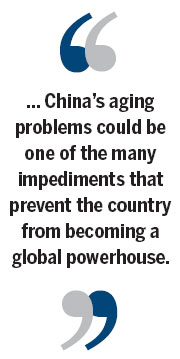Hard lessons from the US
Updated: 2013-05-10 08:45
By Benjamin Shobert (China Daily)
|
|||||||||||

Housing for seniors is not simply a real estate challenge
The numbers are staggering: by 2050 more than one-third of China's population will be over 60. Beijing already has more than 1.7 million people over 65, and Shanghai more than 2.3 million. With the incidence of dementia in China projected to more than quadruple by 2040, the country is in desperate need for new senior care models that are financially sustainable and that efficiently pull together the efforts of government and the private sector.
If demographic and economic growth trends hold true, no country in the history of mankind will get as old, or as rich, as fast as China will. The combination of wealth creation and massive societal aging poses many profound challenges to the Chinese government that need to be dealt with. One of the most important issues that needs to be identified and planned for properly now, before problems present themselves, is making sure the senior housing capacity built by the private sector is financially sustainable.
In the late 1980s, US real estate developers were struggling. The recession and stagflation of the 1970s had left many holding under-performing commercial, residential and hotel space. As they looked for new purposes for these developments, many turned to senior housing as a way of changing under-used sites into financially attractive properties. Unfortunately, the results were poor. Many of the redevelopments proved to be financially unsustainable and went bankrupt, leaving seniors stranded in developments that could not afford to keep their doors open.
Others that managed to stay in business were unable to offer the level of healthcare services that seniors who were in search of specialized housing required. By the late 1980s it was obvious that while the demographic need in the US clearly indicated a need for senior housing, the industry needed more than just housing capacity; it needed all-encompassing solutions that addressed the unique personal, familial and financial needs of an aging population. The question was what more would be required for a viable senior care business to emerge in the US.
As often happens in the US, the government was slow to involve itself in the senior living industry. The many failures that occurred in the 1980s indicated that local governments would need to mandate senior living facilities, conduct basic market analysis and prove their particular financing model was sustainable in order to protect vulnerable seniors who did not have the ability to absorb a major setback late in life. Watching the amazing number of senior living facilities springing up around China, now is the time for the central government to ask whether the right safeguards are in place to protect seniors from unsustainable developments as happened in the US in the 1980s.
What would this mean in China? First, municipalities would slow down on approving new senior housing developments until basic due diligence is completed. In the US, new senior housing must prove that a viable local market exists near the planned development and that this group can pay, or authorities will not approve the development. Second, new developments in the US must present a financing model that illustrates how the planned business will continue to be financially profitable even as the healthcare requirements of the elderly moving into the facility become more involved and expensive.
This latter point is extremely important: simply building senior housing with adjustments that take into account the social interests and communal requirements of an older group is straight forward enough. But senior housing is never just housing. Inevitably, and in China's case very quickly, it becomes a healthcare product. As people live longer and age in senior housing communities, they need to have access to different kinds of support and healthcare services than was originally planned. If developers are not required by government to take these factors into account, a lot of housing will be built that does not reflect the likely needs related to dementia care, stroke rehabilitation or palliative and hospice care that have been proven worldwide to be necessary components of integrated senior care solutions.
The role of real estate in China's amazing growth story is well understood. It has been a powerful engine that has directed much of the country's economy for the last several decades. But if senior housing is viewed primarily as a real estate transaction, and not through the lens of ensuring financially sustainable solutions are built that address the long-term healthcare and social needs of China's aging population, China's aging population could be one of the many impediments that prevent the country from becoming a global powerhouse many expect it to be.
The simplest of steps, forcing developers to embrace more comprehensive market analysis and due diligence, would go a long way toward ensuring China's approach to senior care reflects the hard lessons learned in the US when real estate developers moved too quickly into senior care without a full grasp of the sort of long-term commitment it represented.
The author is the founder and managing director of Rubicon Strategy Group, a consulting firm specializing in helping American and European companies enter emerging markets.
(China Daily 05/10/2013 page7)
Today's Top News
List of approved GM food clarified
ID checks for express deliveries in Guangdong
Govt to expand elderly care
University asks freshmen to sign suicide disclaimer
Tibet gears up for new climbing season
Media asked to promote Sino-Indian ties
Shots fired at Washington Navy Yard
Minimum growth rate set at 7%
Hot Topics
Lunar probe , China growth forecasts, Emission rules get tougher, China seen through 'colored lens', International board,
Editor's Picks

|

|

|

|

|

|





